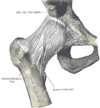
Ortolani test
Encyclopedia


Physical examination
Physical examination or clinical examination is the process by which a doctor investigates the body of a patient for signs of disease. It generally follows the taking of the medical history — an account of the symptoms as experienced by the patient...
for developmental dysplasia of the hip
Hip dysplasia (human)
Hip dysplasia, developmental dysplasia of the hip or congenital dysplasia of the hip is a congenital or acquired deformation or misalignment of the hip joint.-Terminology:...
.
It is performed by an examiner first flexing the hips and knees of a supine infant to 90 degrees, then with the examiner's index fingers placing anterior pressure on the greater trochanter
Greater trochanter
The greater trochanter of the femur is a large, irregular, quadrilateral eminence and a part of the skeletal system.It is directed a little lateralward and backward, and, in the adult, is about 1 cm lower than the head...
s, gently and smoothly abducting the infant's legs using the examiner's thumbs.
A positive sign is a distinctive 'clunk' which can be heard and felt as the femoral head
Femur head
The femur head is the highest part of the thigh bone . It is supported by the neck of the femur.The head is globular and forms rather more than a hemisphere, is directed upward, medialward, and a little forward, the greater part of its convexity being above and in front.Its surface is smooth,...
relocates anteriorly into the acetabulum
Acetabulum
The acetabulum is a concave surface of the pelvis. The head of the femur meets with the pelvis at the acetabulum, forming the hip joint.-Structure:...
:
Specifically, this tests for posterior dislocation
Dislocation (medicine)
Joint dislocation, or luxation , occurs when bones in a joint become displaced or misaligned. It is often caused by a sudden impact to the joint. The ligaments always become damaged as a result of a dislocation...
of the hip.
This is part of the standard infant exam performed preferably in early infancy; it usually becomes negative after 2 months of age.
It is performed with the Barlow maneuver
Barlow maneuver
The Barlow maneuver is a physical examination performed on infants to screen for developmental dysplasia of the hip. It is named for T.G. Barlow, 1962 at Hope Hospital Salford, Manchester....
and inspection
Inspection (medicine)
In medicine, inspection is the thorough and unhurried visualization of the client. This requires the use of the naked eye.During inspection, the examiner observes:External signs:...
of the hip joint and legs.
It is named for Marino Ortolani
Marino Ortolani
Marino Ortolani was an Italian pediatrician who developed a clinical test for the recognition of hip dysplasia called the Ortolani test.-External links:* - Seyed Behrooz Mostofi...
, who developed it in 1937.

